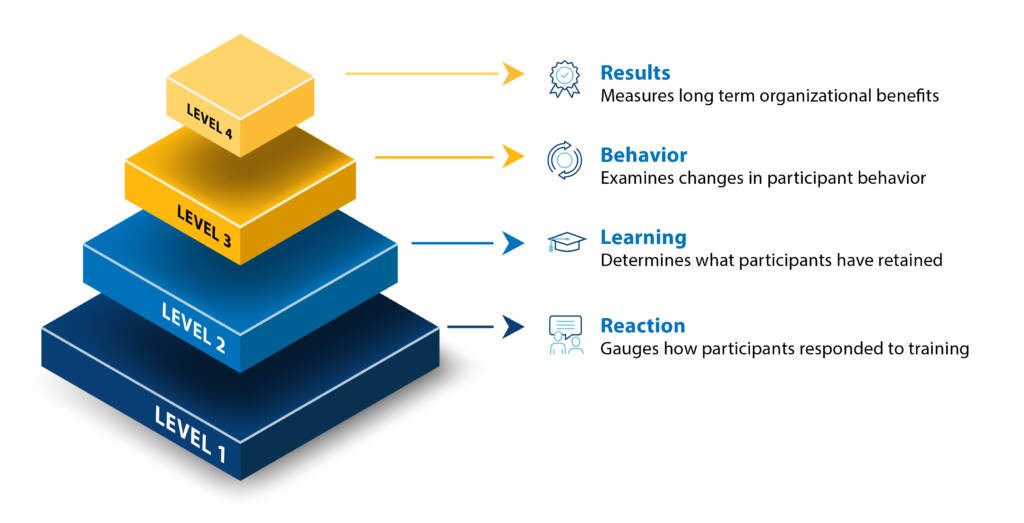In the realm of professional development, investing in training programs is often a strategic move aimed at enhancing employee skills, boosting productivity, and ultimately driving organizational success. But how can we ensure that these training initiatives are not only effective but also aligned with broader business objectives? Enter the Kirkpatrick Model.
Understanding the Kirkpatrick Model
Developed by Donald L. Kirkpatrick in the 1950s and later refined with his son James D. Kirkpatrick, the Kirkpatrick Model offers a comprehensive framework for evaluating training programs. It consists of four distinct levels, each providing valuable insights into the effectiveness and impact of training:

Level 1: Reaction
At this initial level, the focus is on participants’ immediate reactions to the training experience. This could involve their satisfaction with the content, delivery method, trainer, and overall learning environment. Feedback forms, surveys, or post-training evaluations are commonly used to gather this data.
Level 2: Learning
Moving beyond mere satisfaction, Level 2 delves into the extent to which participants have actually acquired new knowledge, skills, or attitudes as a result of the training. Pre- and post-training assessments, quizzes, or tests can help measure the increase in knowledge or changes in behavior following the training.
Level 3: Behavior
Here, the evaluation shifts to the application of newly acquired knowledge and skills in the workplace. Are employees translating what they learned during the training into tangible actions or behaviors on the job? Observations, performance evaluations, or follow-up assessments can shed light on this aspect.
Level 4: Results
At the pinnacle of the Kirkpatrick Model lies Level 4, which examines the broader impact of the training on organizational goals and outcomes. This could encompass metrics such as increased productivity, improved customer satisfaction, higher sales figures, or reduced error rates. Ultimately, Level 4 evaluation seeks to determine whether the training has delivered tangible results that align with the organization’s objectives.
Real-Life Examples
Let’s explore how the Kirkpatrick Model can be applied in real-world scenarios to evaluate training effectiveness:
Example 1: Customer Service Training
A retail company invests in a customer service training program for its frontline staff. Following the training:
Level 1 (Reaction): Participants express high satisfaction with the training content and trainers based on post-training surveys.
Level 2 (Learning): Pre- and post-training assessments reveal a significant improvement in employees’ knowledge of customer service principles and techniques.
Level 3 (Behavior): Supervisors observe a noticeable increase in employees’ use of active listening and problem-solving skills when dealing with customers.
Level 4 (Results): The company records a subsequent rise in customer satisfaction scores and repeat business, indicating the training’s positive impact on overall service quality and customer loyalty.
Example 2: Leadership Development Program
A multinational corporation launches a leadership development program for its mid-level managers. After completing the program:
Level 1 (Reaction): Participants provide positive feedback on the program structure, guest speakers, and networking opportunities during feedback sessions.
Level 2 (Learning): Pre- and post-program assessments demonstrate a marked improvement in managers’ leadership competencies, such as communication, decision-making, and team building.
Level 3 (Behavior): Performance evaluations reveal that managers are applying newly acquired leadership skills to foster team collaboration, drive innovation, and achieve strategic objectives within their departments.
Level 4 (Results): The company observes an increase in employee engagement levels, a reduction in turnover rates, and a measurable impact on key performance indicators (KPIs) such as revenue growth and market share, attributable to the strengthened leadership capabilities of its managers.
Conclusion
In today’s competitive business landscape, evaluating the effectiveness of training programs is essential for maximizing return on investment and driving sustainable organizational success. By employing the Kirkpatrick Model, organizations can systematically assess training initiatives at multiple levels, from immediate reactions to long-term results. Through this holistic approach to training evaluation, businesses can ensure that their training efforts are not only impactful but also aligned with strategic objectives, ultimately leading to enhanced performance, increased productivity, and a more engaged workforce.

